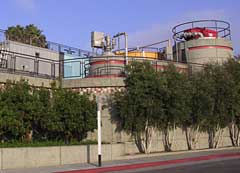
SMURRF
 The SMURRF |
The people of Santa Monica know that Santa Monica Bay is the heart of their image as a beach town, and the reason that thousands of tourists flock to their hotels and shopping malls every year.
As the 1980s and 90s progressed, however, the Bay got more and more polluted. As factories and sewage plants were cleaned up it became clear that the majority of the remaining pollution in the Bay came not from industrial waste, but from urban runoff.
Runoff pollution happens when rainwater, or water from washing cars, watering lawns or hosing off sidewalks, flushes chemicals and trash lingering in streets, yards and parking lots into the storm drain systems and out into the ocean. Common pollutants are motor oil, gasoline, lawn fertilizers, pesticides, animal feces and trash.
 |
Polluted urban runoff has become one of the banes of modern cities. Coming from dispersed sources all over the city, it's difficult to prevent. Many cities have launched education campaigns to teach residents about the dangers of leaving motor oil, pesticides or garbage on the streets, but it's not working fast enough. Cities are facing state and federal deadlines to clean up their waterways, and wondering what to do.
Santa Monica is the first city in the country, probably in the world, to build a treatment plant to clean and recycle urban runoff. The Santa Monica Urban Runoff Recycling Facility, an unobtrusive concrete and tile structure, sits on the coast just before Santa Monica pier.
 The Santa Monica Urban Runoff Recycling Facility |
Built at a cost of $12 million, shared between Santa Monica, Los Angeles and other local, state and federal agencies, the SMURRF captures up to 500,000 gallons a day of runoff water from two large storm drains that together drain 5,100 acres of Santa Monica and Los Angeles.
The water first runs through a coarse screen to remove large objects and trash. After a major storm workers have found boards, car parts, and a concrete block as large as a person in the coarse screener.
 Clean water leaving the SMURRF |
It then passes through a fine screening to remove all particles greater than 0.04 inches in size. The water is screened one more time to remove even finer grit. After collecting in a chamber, it passes through a dissolved air flotation unit, where air is injected into the bottom of the tank. As the bubbles travel upward, they carry oil and grease to the top where they are skimmed off.
Next it is forced through a microfiltration unit, where long fibers like giant pasta filter cloudiness from the water. Finally the water is disinfected by exposure to ultra-violet light, which kills bacteria and viruses. The finished water is then pumped throughout the city to be used for landscape irrigation, such is the city's cemetery and parks. In the future, Santa Monica plans to use the water to flush toilets in some of its new buildings.
 |
The SMURRF has helped in the dramatic cleanup of Santa Monica Bay, by decreasing the amount of polluted runoff by 90%.